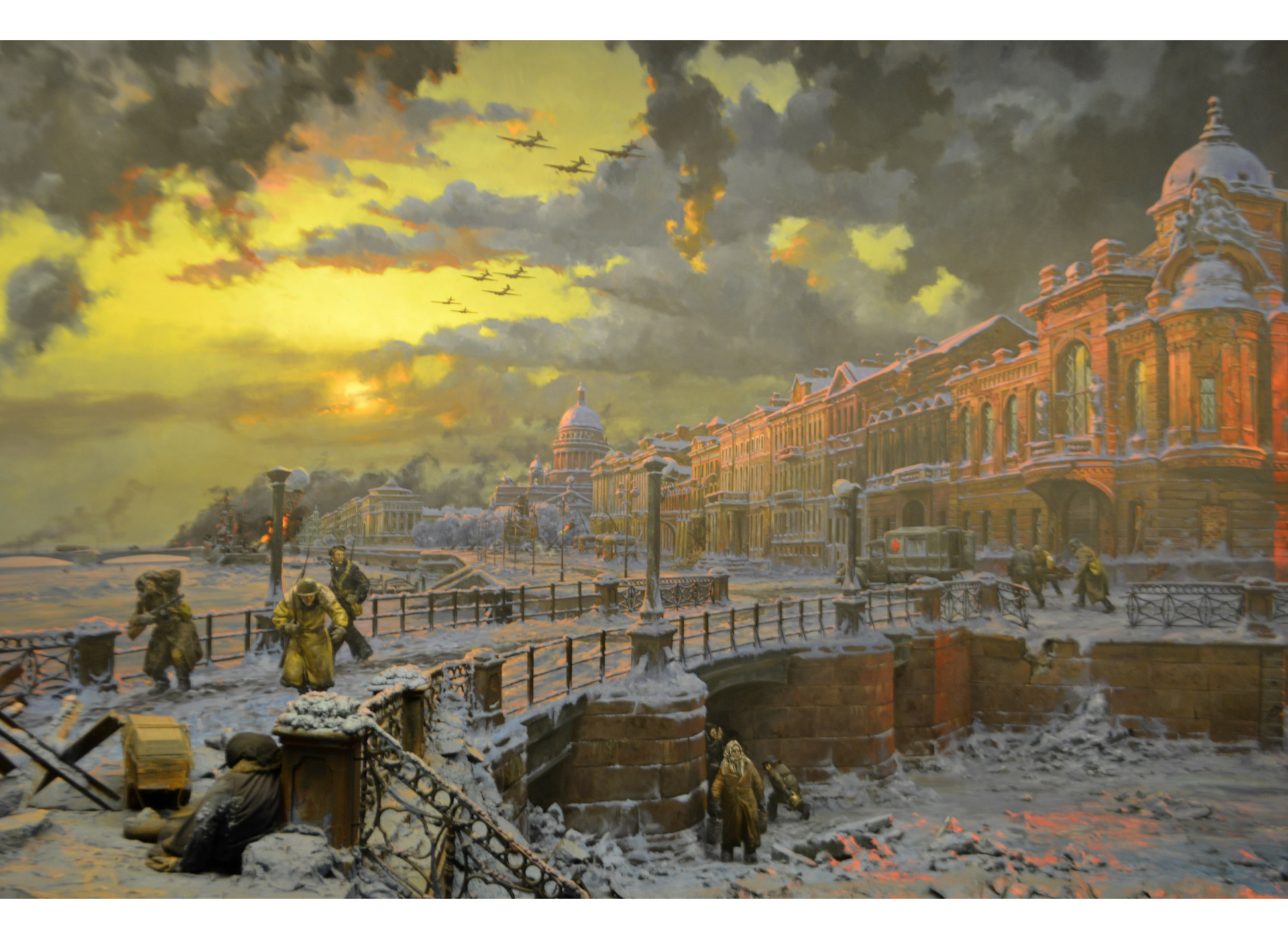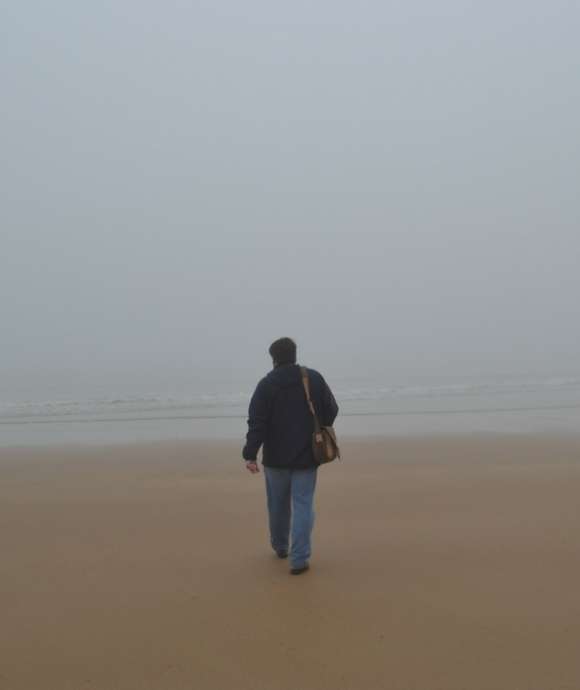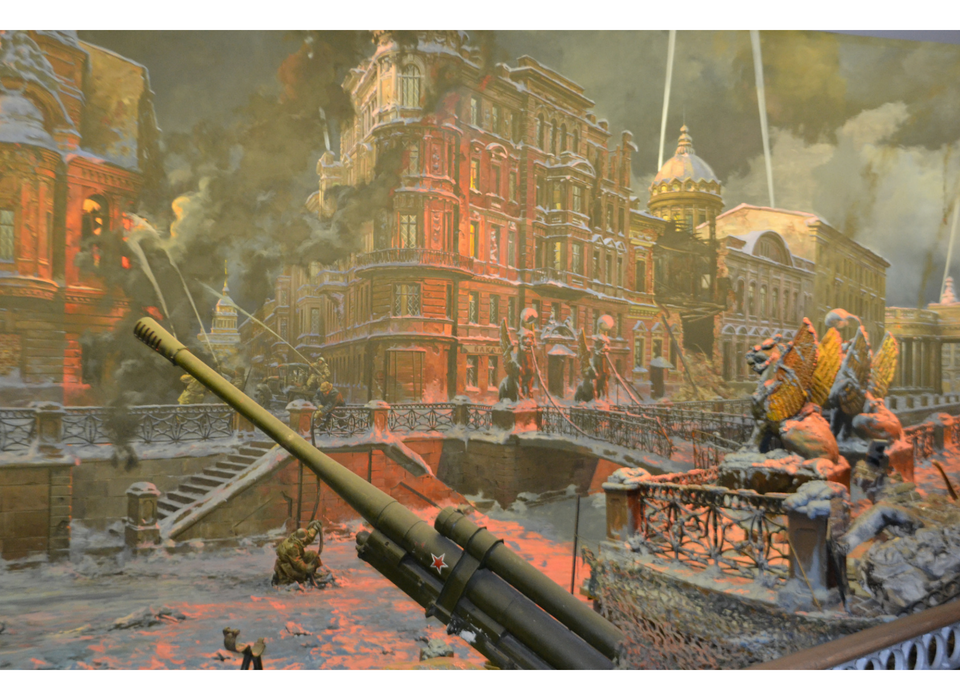In my last post, I discussed the epic battle at Stalingrad, savagely fought by the Red Army along the banks of the Volga River from August 23, 1942, until the German surrender and final victory on February 2, 1943. After 132 days of battle, the city was left virtually demolished. But another epic battle was ongoing at the same time far to the north. The Germans had commenced shelling Leningrad a year before the start of battle at Stalingrad, and after the Red Army claimed victory there, virtually another year of fighting was needed before the Soviets could claim victory at Leningrad.
The siege of Leningrad (St. Petersburg before the Russian Revolution) would last 872 days, six and half times as long as the battle for Stalingrad, and saw suffering on a previously inconceivable scale. In the early stages of Operation Barbarossa, the German Army Group North drove through the Baltic territories to Leningrad’s doorstep. The German thrust was aimed at the city that had political, military, and economic significance as it bore Lenin’s name as the birthplace of the Bolshevik revolution, was a port on the Baltic, and a major industrial center. To Adolf Hitler, the conquest of Leningrad was to be a supreme symbol of Nazism’s ideological triumph over international communism. After a few weeks of artillery shelling that began in August 1941, the siege of the city officially began with its landed encirclement by German forces on September 8, 1941, three full months before the Japanese attack on Pearl Harbor brought the United States into the war. The siege lasted until January 27, 1944, meaning that the contest for Leningrad encompassed both of the great Soviet victories at Stalingrad and Kursk in the summer of 1943 before victory could be claimed there.
The museum of the Great Patriotic War in Moscow employs a series of dioramas to tell the story of the Nazi-Soviet war from 1941-1945. Without text panels or interactive show elements, these dioramas are quite striking in how they convey the history of the war and through their artistic presentation invoke intuitive feelings for the realities of what it must have been like to be there for visitors. The Leningrad diorama is particularly striking because of the details of the city. In the lead image to this post, one can clearly see in the diorama the drama of a city under siege. The scene depicts the Bank Bridge along the Griboedov canal, a small pedestrian bridge clearly recognizable for the two gold-winged griffons that flank it (the griffons were created by the sculptor Pavel Sokolov in 1825-1826). Visible through the smoke and destruction, far down the street, is the dome of St. Isaac’s Cathedral. The dome of Kazan Cathedral appears to the right of the viewer a few blocks down the canal and spotlights search for enemy aircraft. What would in peacetime be a beautiful and charming scene of city life in Leningrad (St. Petersburg today) is transformed by the oppressive atmosphere of war, as white, grey and black billows flood the sky. In the streets, men attempt to put out fires in the burning buildings. On the icy surface of the frozen canal can be seen a man feeding a hose through the ice in order to pump water into the fires. In the foreground an anti-aircraft gun stands at ready, lending an air of physical reality to the scene.
Before it, above all, one feels cold. In another part of the diorama, in a view that I interpret as a canal connecting to the Neva River with St. Isaac’s Cathedral dome again in the background at dawn, one can sense the sheer struggle to survive in the city under siege. An ambulance truck stands on the other side of the bridge as planes streak overhead, while under the bridge some civilians appear to be peering out to see where the planes are going. Soldiers on the bridge appear to be more accustomed to the danger. Everywhere is smoke, ice, snow, random fires, and a sense of heavy, freezing air that one can imagine slightly burning as it goes in and out of the lungs.

If one can imagine what being in such an urban environment under siege was like, how hard it was for people to survive, then one can begin to glimpse more deeply the suffering of the vast numbers who did not survive. Out of a population of over three million people before the war, approximately 1.5 million soldiers and civilians perished during the siege of Leningrad. The worst period was the winter of 1941-1942. There are documented cases where people ate wood dust, glue from wallpaper, and many other inedible items. Families exchanged beloved pets for consumption. There were incidents of cannibalism. In the end, mass starvation took hundreds of thousands. Today, the Piskaryovskoe Memorial Cemetery alone contains in mass graves the remains of half a million people who perished in the siege. These are horrors that I believe are impossible and inappropriate to convey in a diorama meant for viewing by children and the general public.
Due to its beautiful canals and waterways, I once heard St. Petersburg called the Venice of northern Europe, and one of the things I liked about the diorama is that one can imagine how beautiful and lovely these scenes along the canals and bridges would be in peace (and are today). But students of history should know and reflect on the realities that underlie these scenes when they view them in a museum.
Students and visitors should also know that although Hitler had vowed to raze the city and the Germans enforced the most lethal siege in history, in the end, Leningrad did not break. It would be nearly a full year after the victory at Stalingrad before the Germans would retreat from Leningrad. In between that time, the greatest tank battle in history took place at Kursk. This will be the subject of my next post.
This is the third post about the Museum of the Great Patriotic War. Read Part One. Part Two. Part Four. Part Five. Part Six. Part Seven. Part Eight.

"No matter one’s age, travel is a unique and exciting educational experience. In my work, I have had the opportunity to reflect on history, events, and people in the places where they experienced life. Through the viewfinder, we can not only find history and perspective, but create memory, and evoke our evergreen past."
– Keith Huxen, PhD, Senior Director of Research and History, The National WWII Museum
Keith Huxen
Keith is the former Senior Director of Research and History in the Institute for the Study of War and Democracy at The National WWII Museum.
Cite this article:
MLA Citation:
APA Citation:
Chicago Style Citation:





![Max Fuchs, New York City cantor, sings as Rabbi Sydney [sic] Lefkowitz, Richmond, VA, conducts the first Jewish services from Germany.](/sites/default/files/styles/max_650x650/public/2025-10/image1.jpg)



